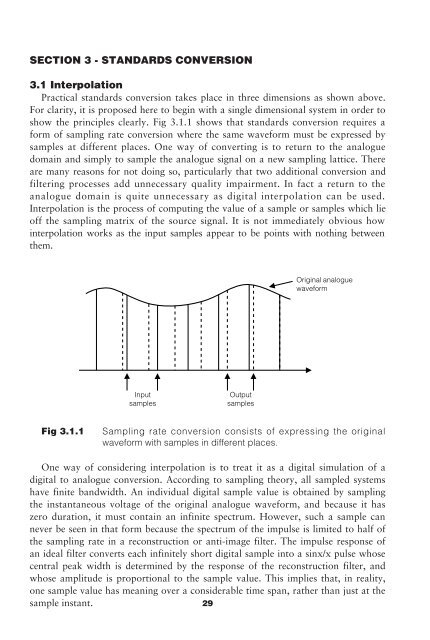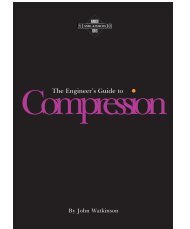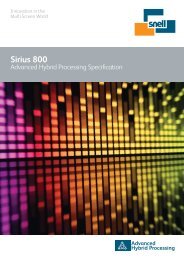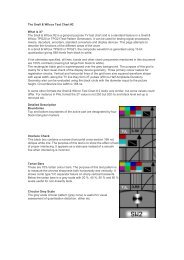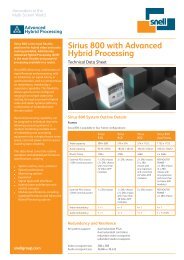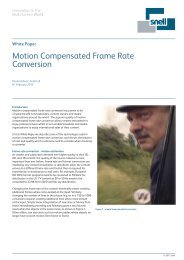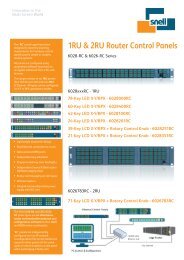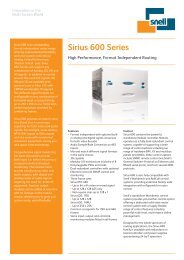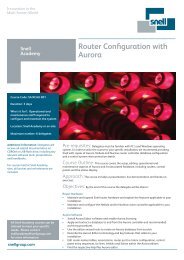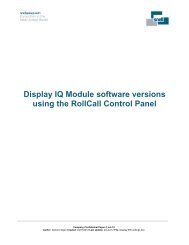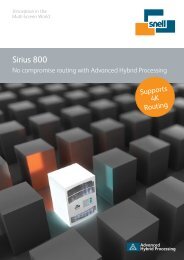The Engineer's Guide to Standards Conversion - Snell
The Engineer's Guide to Standards Conversion - Snell
The Engineer's Guide to Standards Conversion - Snell
Create successful ePaper yourself
Turn your PDF publications into a flip-book with our unique Google optimized e-Paper software.
SECTION 3 - STANDARDS CONVERSION<br />
3.1 Interpolation<br />
Practical standards conversion takes place in three dimensions as shown above.<br />
For clarity, it is proposed here <strong>to</strong> begin with a single dimensional system in order <strong>to</strong><br />
show the principles clearly. Fig 3.1.1 shows that standards conversion requires a<br />
form of sampling rate conversion where the same waveform must be expressed by<br />
samples at different places. One way of converting is <strong>to</strong> return <strong>to</strong> the analogue<br />
domain and simply <strong>to</strong> sample the analogue signal on a new sampling lattice. <strong>The</strong>re<br />
are many reasons for not doing so, particularly that two additional conversion and<br />
filtering processes add unnecessary quality impairment. In fact a return <strong>to</strong> the<br />
analogue domain is quite unnecessary as digital interpolation can be used.<br />
Interpolation is the process of computing the value of a sample or samples which lie<br />
off the sampling matrix of the source signal. It is not immediately obvious how<br />
interpolation works as the input samples appear <strong>to</strong> be points with nothing between<br />
them.<br />
Original analogue<br />
waveform<br />
Input<br />
samples<br />
Output<br />
samples<br />
Fig 3.1.1<br />
Sampling rate conversion consists of expressing the original<br />
waveform with samples in different places.<br />
One way of considering interpolation is <strong>to</strong> treat it as a digital simulation of a<br />
digital <strong>to</strong> analogue conversion. According <strong>to</strong> sampling theory, all sampled systems<br />
have finite bandwidth. An individual digital sample value is obtained by sampling<br />
the instantaneous voltage of the original analogue waveform, and because it has<br />
zero duration, it must contain an infinite spectrum. However, such a sample can<br />
never be seen in that form because the spectrum of the impulse is limited <strong>to</strong> half of<br />
the sampling rate in a reconstruction or anti-image filter. <strong>The</strong> impulse response of<br />
an ideal filter converts each infinitely short digital sample in<strong>to</strong> a sinx/x pulse whose<br />
central peak width is determined by the response of the reconstruction filter, and<br />
whose amplitude is proportional <strong>to</strong> the sample value. This implies that, in reality,<br />
one sample value has meaning over a considerable time span, rather than just at the<br />
sample instant.<br />
29


